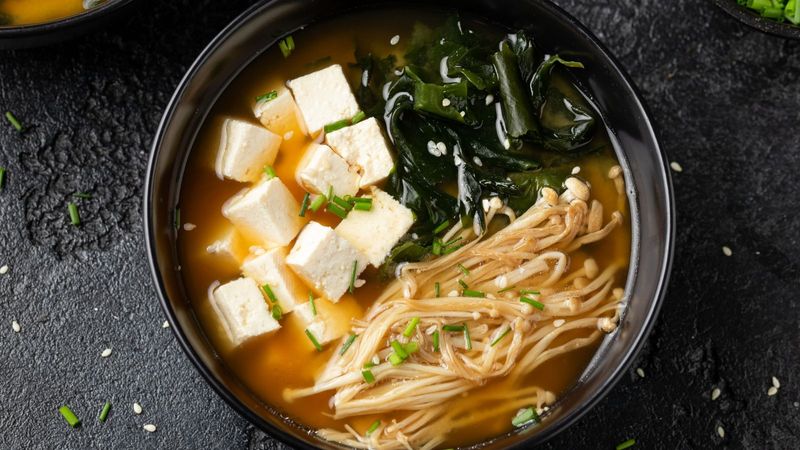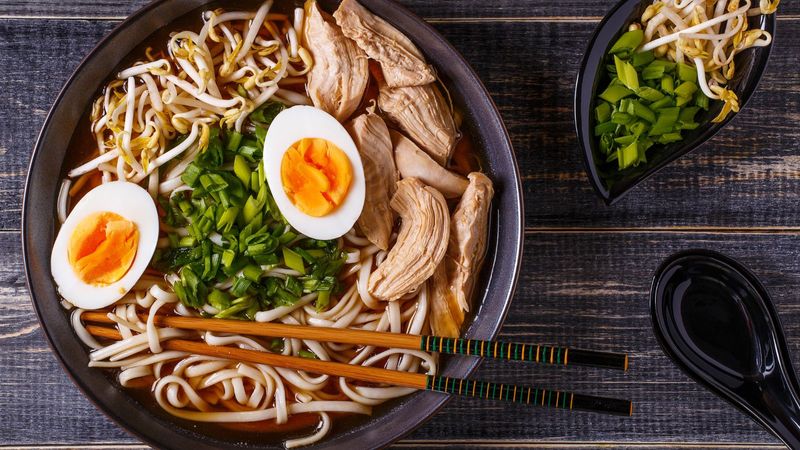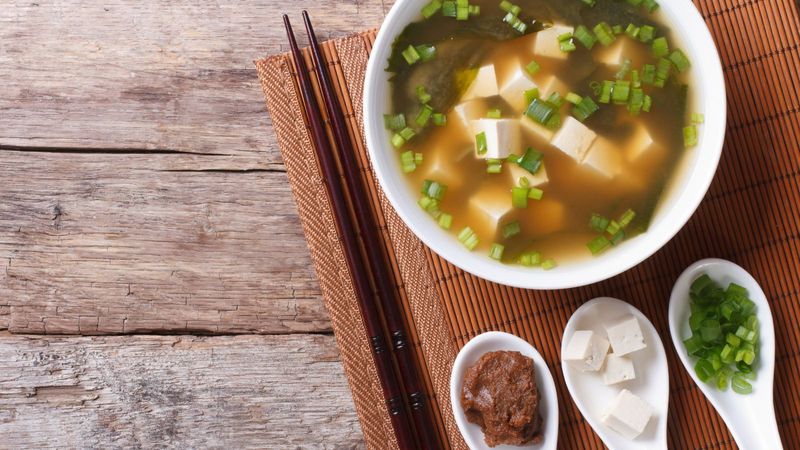A comforting, soothing soup for the soul, Japanese miso soup is a must-try, especially in the relentless Indian monsoons. Miso soup is a staple in Japanese cuisine and can be eaten for breakfast, lunch or dinner. One of the easiest meals to make at home, this Japanese miso soup recipe will come together in under 30 minutes. The hero ingredient in the miso soup preparation is the miso paste, which is made by fermenting soybeans with grains and a fermentation starter like koji.
Health benefits of miso soup

As a country with some of the longest-living people in the world, Japanese food practices have inspired and influenced eating habits worldwide. Much like matcha or green tea, miso soup lies at the core of the Japanese diet, providing excellent health benefits:
- Reduced Cholesterol: Miso contains Vitamin K2, linoleic acid, and saponin which lower cholesterol, reducing the risk of heart disease.
- Bone Health: Calcium, Magnesium and Manganese present in miso help improve bone density, which keeps our bones healthy even in old age by reducing the occurrence of osteoporosis.
- Natural Health Supplement: With the regular inclusion of Japanese miso soup in your diet, you get a natural dose of copper and zinc, essential minerals for your functioning.
Making Japanese miso soup at home, with fresh ingredients will help you unlock most of these benefits, which an instant miso soup may not. Premixes of miso soup, or any other soup for that matter often contain high amounts of sodium to increase its shelf-life, which poses the risk of increased blood pressure in the long run.
Miso ramen noodles and miso soup: Are they similar?

If you enjoy the miso flavour and want to incorporate it into more of such authentic recipes, you should try making miso ramen noodles, which consist of a miso ramen soup, fresh ramen noodles and toppings like egg, leeks, mushrooms, seaweed, bamboo shoots and if you’re a meat eater, braised pork belly. The base for the miso ramen varies from the dashi used in the Japanese miso soup preparation. However, miso ramen can be made by preparing toppings and broth ahead of time, especially if you have made the miso soup and are familiar with using miso.
3-step-process to make miso soup at home
You can never feel bored of eating miso soup because once you have mastered the basics, there is no end to the variations you can bring in. Making a good, authentic miso soup preparation has three basic steps. First is making the dashi or the Japanese soup stock. This is the base of the miso soup which comes together in 20 minutes. Making the dashi for miso soup from scratch might feel like additional work, but resist the temptation of simply using vegetable stock or chicken stock in its place, for it is dashi that will make miso soup worth trying. Traditionally made from kelp and bonito flakes, dashi can also be made by vegetarians using ingredients like mushrooms and seaweed.
The next step is to add miso paste to the dashi. Generally speaking, one tablespoon of miso paste is added per miso soup bowl, which is about 200 ml of broth or dashi. However, miso comes in various kinds and brands, so the best way to decide the quantity is to check the packet for details, and taste and correct your miso soup recipe as you go.
Finally, it is time to add toppings to your miso soup preparation. We add the tofu, green onions or seaweed after the miso has dissolved in the dashi. This way, you won’t end up crumbling the tofu while mixing in the miso paste. You can also use any other local or seasonal veggies. If adding root vegetables, add them to a cold dashi and then bring to a simmer to cook them. If you are cooking with green leafy vegetables or mushrooms you add them to an already simmering dashi.
Miso soup ingredients
For the Dashi
- 4 cups water
- 1 piece kombu (dried kelp)
- 1 cup katsuobushi (dried bonito flakes)
For the Miso Soup
- 200 g soft/silken tofu, cubed
- 4–5 tbsp miso
- 1 tbsp dried wakame seaweed
- 1 spring onion, sliced
Miso soup recipe

Soak the kombu
- Add 4 cups water and 1 piece of kombu to a medium-sized saucepan.
- Soak the kombu in water for 30 minutes. Be careful not to wash kombu- the white substance on it needs to be preserved for the flavour. If you see dirt particles, scrape them off without washing the entire piece of kombu.
- Turn the heat on after 30 minutes, slowly bringing the pan close to a boil in 10 minutes. This helps extract umami from the kombu.
- Just before the liquid starts boiling, remove the kombu and set it aside. Leaving it in longer will make your dashi bitter and slimy. What you have is a kombu dashi- perfect for vegetarians. This is the stock to be used in the miso soup preparation.
- If you're not vegetarian, add 1 cup of katsuobushi to the kombu dashi and bring it to a boil once again. Once the dashi starts boiling, reduce the heat, and simmer for 30 seconds.
- Turn off the heat and let the flakes sink to the bottom. After 10 minutes, strain through a fine-mesh sieve. Awase dashi is ready to be used for the miso soup recipe.
- Add 4-5 tbsp of miso paste to the dashi. To do this, first, take miso in a ladle or small bowl, then add some hot dashi to make a concentrated slurry and dissolve the miso. Then mix this into the saucepan with the remaining dashi.
- Ensure the miso is completely dissolved. If there are any undissolved grains of koji in the stock, you can strain them or leave them in, based on your preference.
- Add tofu cubes to the miso soup preparation.
- Right before serving, Add 1 Tbsp dried wakame seaweed and spring onions to the saucepan. In case you are reheating the miso soup, warm it up until it is just hot. Boiling it entirely will take away from its aroma and flavour.
There you go! Your simple, flavourful and nourishing Japanese miso soup is ready. Try it, explore different flavours and combinations of toppings and enjoy the umami goodness to the fullest!




